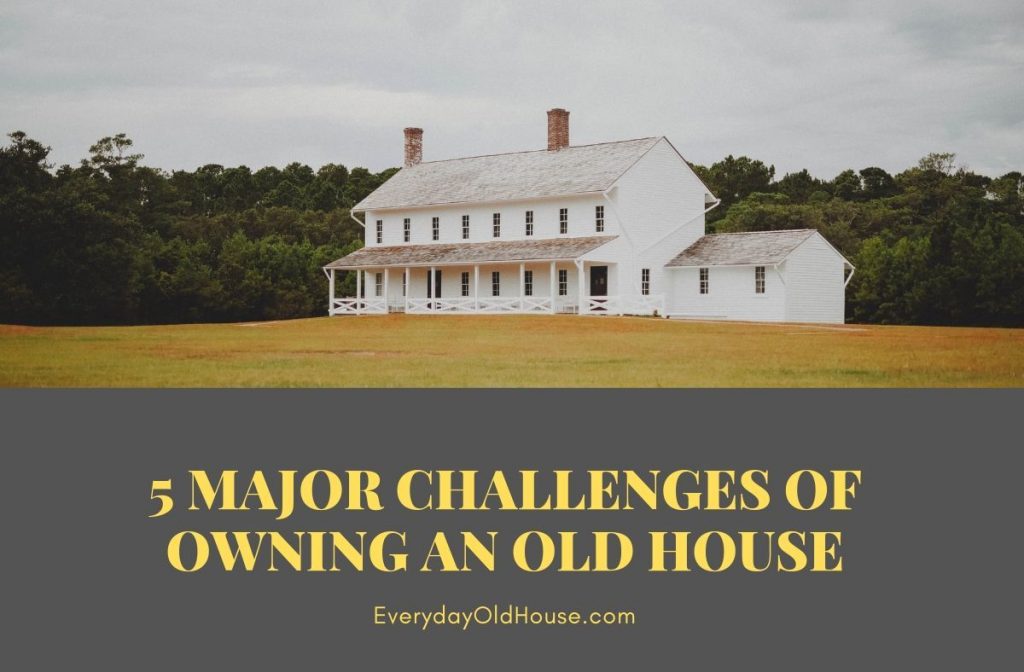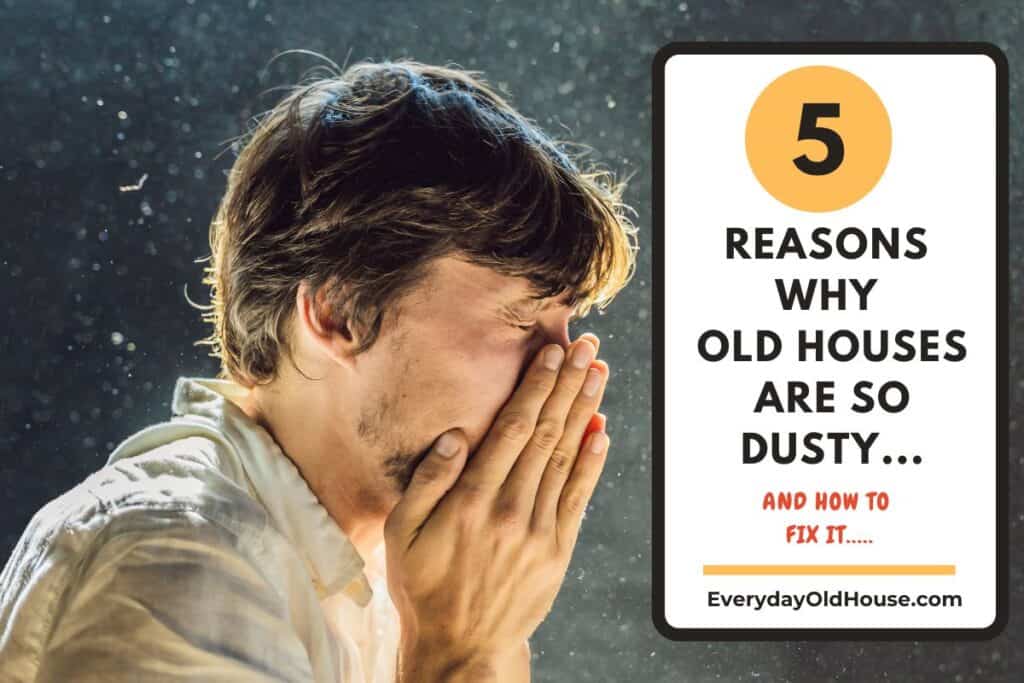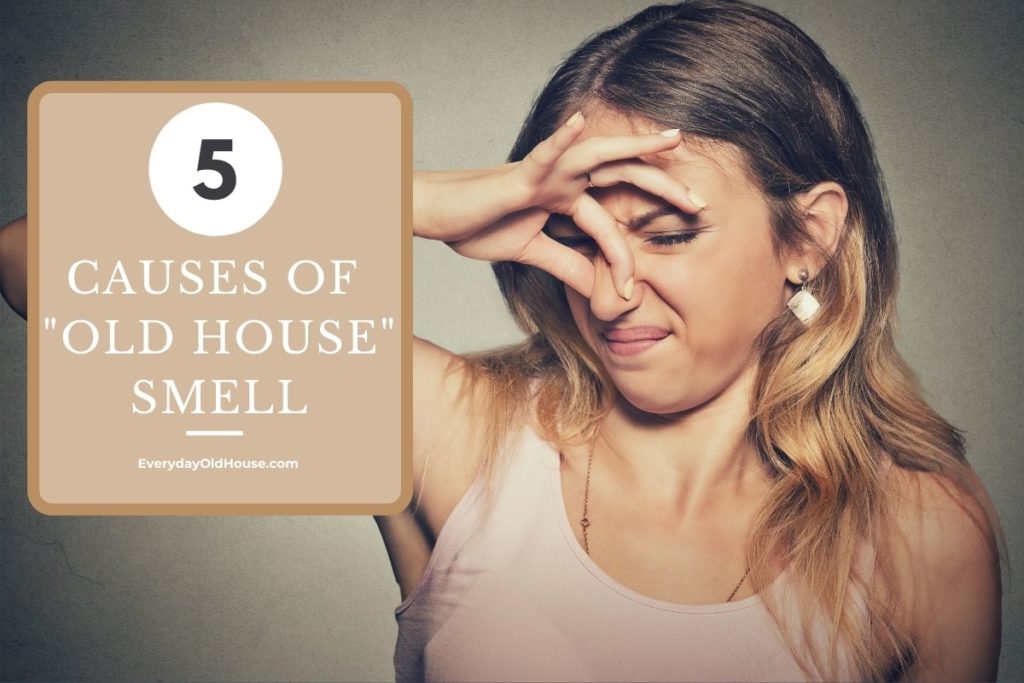Last Updated on July 2, 2024
Intoxicated by the charm and beauty of an owning an old house? Or have a minuscule house budget that only considers homes older than your grandma? If you’re considering buying an old house (or maybe already own one), it’s important you understand the potential environmental dangers of older homes.
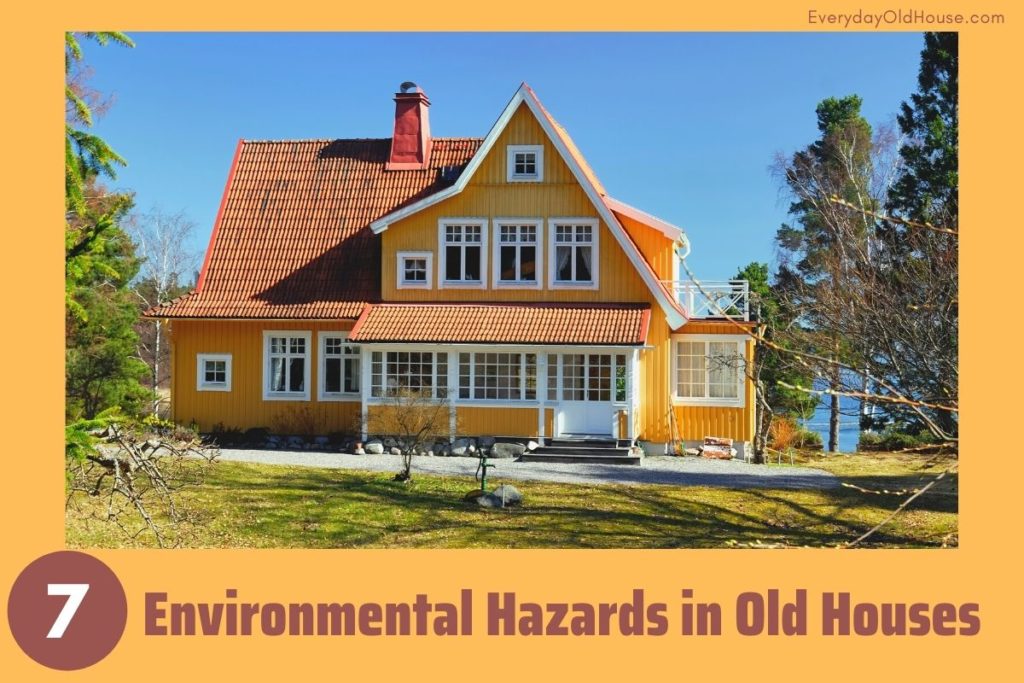
Environmental Dangers in Old Houses
Homeownership of any home, new or old, can be challenging. However, older homes have additional challenges, including additional maintenance, increased fire risk, and environmental hazards.
In general, these 7 environmental dangers in old houses have the potential to cause undesirable health effects to the homes residents, and include:
- Asbestos
- Lead-Based Paint
- Lead in Drinking Water
- Mold
- Carbon Monoxide
- Radon (well, kind of…keep reading)
- Underground Storage Tanks
Note that this list of environmental dangers are not meant to scare you away! Personally, I think these risk are SO worth the fun and character of living in an old house. (It also helps that I worked professionally in the environmental consulting arena for 20+ years and have a higher comfort level than the average homeowner).
Personally, I think these hazards are fairly easy to get your arms around. And second, I believe that all but one of the hazards outlined below (carbon monoxide) are actually lower risk than other well-known home safety risks, such as falls and poisonings. But, just my two cents…. speaking of which….
Disclaimer
Before we start, I need to add this disclaimer. I’m an average homeowner, not an environmental health expert. (ok, ok admittedly I do have a degree in Environmental Engineering/ Enviro Health BUT I don’t consider myself an expert…
[If you want a good laugh, check out my 1990’s HUGE glasses back when I was an academic and the summary of my Master’s thesis “Ranking Risks in the Home“]
But I digress….
Consider this post of environmental dangers in old houses merely as a springboard to the experts. A conversation-starter to get you connected to the most accurate and up-to-date information. Do not rely on just the information in this post to make decisions about your home and your family’s health. Please click on the links provided below, especially the ones for the US Environmental Protection Agency (EPA). They are the experts. Use their guidance and recommendations.
1. Asbestos
Asbestos has a remarkable ability to insulate and fireproof, which made it the prime component in a myriad of home building materials. Or at least, until the US federal government ban in the 1970s- 1980s once it was determined that asbestos caused health effects.
Where can you find asbestos in old homes? The most common use was as insulation around boilers and pipes. But, as shown in the infograph below, it was also used in a variety of construction materials – old floor tiles, ceiling tiles, roof shingles and flashing, siding, pipe cement, and joint compound used on seams between pieces of sheetrock. Whew – that’s a lot of places!

If you have an old house, there is some good news. The mere presence of asbestos in your home is not a hazardous conditions. As long as the building material containing asbestos is encased and in good condition, there should be no exposure to asbestos.
However, if building material is damaged and the asbestos is crumbling, asbestos fibers may be released into the air. And that’s where the exposure happens. If residents inhale these fibers for a prolonged period of time, their risk for lung cancer and other respiratory problems is increased.
If interested in learning more details about asbestos click here.
2. Lead- Based Paint
Historically, lead was added to paint to speed up drying, create a longer-lasting finish, and resist moisture. In 1978, the US federal government banned the addition of lead to paints.
Homes built prior to 1978 potentially contains lead-based paint. According to the Environmental Protection Agency (EPA) and the graph below, lead paint is still present in millions of homes, sometimes under layers of newer paint.
Lead from paint can get into the body several ways. First is through ingestion. Lead-based paint chips can be ingested directly, the prime example being a toddler who chews on window sills. Deteriorating exterior paint can chip off and into soil/ gardens abutting the house. Children can ingest soil and paint chips via hand-to-mouth activities. Second is through inhalation. Lead dust forms from lead-based paint is scraped, sanded or heated.
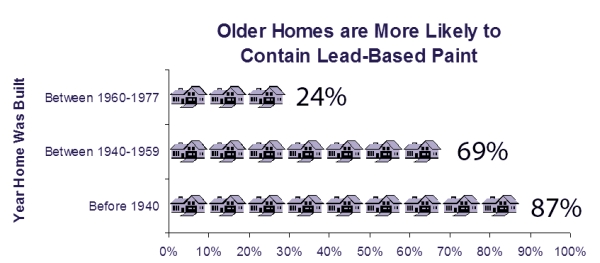
While lead can cause health issues in adults, children are most susceptible to lead poisoning. Even low levels of lead ingested by children can result in behavior and learning problems, lower IQ, and slowed growth.
Like asbestos, if lead-paint is encased, is usually not a health problem. However, older houses with paint that is peeling, chipping, or cracking is a hazard. This needs immediate attention, especially painted areas known for high wear-and-tear, and surfaces assessible to children:
- Window sills
- Doors frames
- Railings and banisters
Note that it is possible to abate/ remove the lead-based paint from your home, but if done improperly, it can actually increase your risk of exposure.
To learn more about lead-based paint as environmental dangers in old houses, read the EPA’s Protect Your Family from Lead in Your Home.
3. Lead in Drinking Water
Unfortunately, lead hazards aren’t just in paint. Lead may also be potentially in your drinking water.
Lead has been used in drinking water pipes for centuries. In the United States, large scale installation of lead pipes for drinking water began in the late 1800s. Lead was preferred over its competitor (iron) because it was more malleable (i.e. easier to bend) and more durable.
But by the 1920, the United States started moving away from lead in drinking water pipes due to awareness of lead poisoning. But installation of lead pipes continued until the 1970s and 1980s.
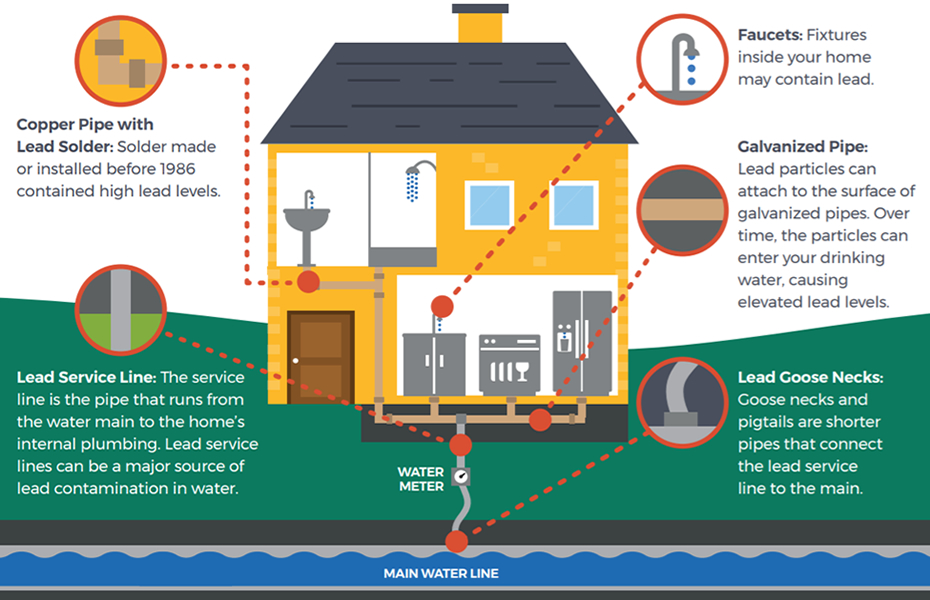
If you live in an older city or own a house built before 1986, you may have lead in your drinking water system pipes. Lead was historically used in all aspects of the plumbing system – pipes, faucets and fixtures. And when that old piping and lead solder corrode (especially when the drinking water has a high acidity), lead leaches into the drinking water.
Since the mid-1980s the federal government has issued regulations to reduce the amount of lead in drinking water. For example, utilities must ensure the drinking water leaving the facilities are less corrosive to pipes as it travels to your homes.
To read more about lead in drinking water, check out the EPA’s Basic Information about Lead in Drinking Water and Guide to Identify Lead Pipes in Your Home.
4. Mold and Mildew
Mold and mildew naturally enters homes through open doorways, windows, vents, and HVAC systems connected to the exterior. And it stays in low concentrations that are not problematic.
However, mold can grow uncontrollably when combined with water and humidity. And water unfortunately gets into homes easily. Plumbing leak. Roofs leaf. Clogged gutters. High water table after rainstorms. Etc…
And since older homes are more likely to have cracked foundations and leaky pipes, it lends to a greater chance of water to get inside. And the perfect place for mold to grow and call home….
Uncontrolled growth can exacerbate allergies and existing respiratory problems like asthma, or cause more serious infections with people with compromised immune systems.
To learn more, check out the EPA’s Brief Guide to Mold and Moisture in Your Home.
5. Carbon Monoxide
Carbon monoxide (CO) is an odorless, colorless gas formed by the incomplete combustion of fuels. Carbon monoxide is generated as a byproduct from appliances that burn oil, gas or coal (electric poses no threat).
Carbon monoxide normally vents out of the house with no cause no concern. However, a damaged heater or a clogged chimney flue may stop proper ventilation, and cause the gas to accumulate inside the house.
When exposed at low concentrations, this leads to feeling tired. However, at high concentrations, this leads to dizziness, confusion, and even death. And since it is impossible to see, taste or smell carbon monoxide gas, it can kill before you before you are even aware it is in your home. Carbon monoxide is one of the most common causes of poisoning deaths in the US.
The risk of carbon monoxide poisoning is heightened in old houses since they tend to have older furnaces and chimneys in need of maintenance or repair.
To lower the dangers of carbon monoxide in an old house, ensure you have a carbon monoxide detector (along with a smoke detector) and test it on a regular basis. In addition, schedule a regular inspection of your HVAC system and chimney by a licensed contractor.
For more information on carbon monoxide poisoning, check out Center for Disease Control’s Carbon Monoxide Page.
6. Radon
Radon is a radioactive gas found in nearly all soils. Radon gas moves up through the ground and into the home via cracks and other holes in the house’s foundation. Radon can build up in concentration in indoor air. If high levels exist for a prolong period of time, residents are at risk for lung cancer.
I debated whether or not to include radon as one of the environmental dangers in old houses. Why? Because radon isn’t mainly an “old house” problem. High levels of radon can exist in new and old houses. Older homes tend to have more foundation cracks and holes, which allows easily access to radon to seep into an old house. BUT older houses also typically have higher ventilation rate, which can lower the concentrations. But I wanted to include radon in this list to at least get it on your radar and be thinking about it.
To learn more about radon in homes, check out the EPA’s Citizen’s Guide to Radon.
7. Underground Storage Tanks (USTs)
Underground storage tanks (USTs) are large metal containers buried underground typically for the storage of fuel. The risk of having an unknown UST (commonly called a “phantom” UST) on your property is low, but it could still be a possibility. A friend of mine bumped into a phantom UST on his property while having his backyard excavated for a new addition.
When homes converted their fuel source from coal or wood to oil (starting in the 1930s), homeowners needed a place to store their oil. For those homes with basements, it was common to put a tank or bunker in the basement. For those without basements, oil needed to be stored in tanks either outside against the house or buried underground. Typically these home heating USTs were 500 to 1,000-gallons in size.
As time passed, and technology improved, a homeowner could have either converted to gas, or moved to another fuel source. And chances are they left the UST underground and forgot about it, and never told the next owner about the USTs presence.
My personal opinion is that most homeowners would have seen leaving oil in a tank that they paid for as wasting money. And would have used as much of it before any conversion or closing of the tank.
The mere presence of a UST isn’t an environmental hazard. But a leaking UST would be an environmental hazard. Leaked oil could seep into a drinking water well (if present) or seep under the old house’s foundation. If under a house’s foundation, old oil degrades, volatilizes and compromises the home’s indoor air.
To learn more about residential USTs, reach out to your local building department or a local a home inspector who can look for evidence of abandoned oil lines or exterior fill pipes.
Did I forget any environmental dangers in old houses? If so, please let me know!
Related Posts
Want to be the first to know about new posts? Be sure to follow me on Pinterest, Facebook, Instagram or Twitter of even Etsy! Or better yet… Subscribe below!
My monthly (admittedly sometimes more, sometimes less….) emails are like receiving a unexpected letter from an old friend WITHOUT needing to put on your slippers and walk out to your mailbox…. See? I got ya, my friend!)
[Note: My posts are proudly connected to these amazing link parties full of DIY ideas and inspiration!]
